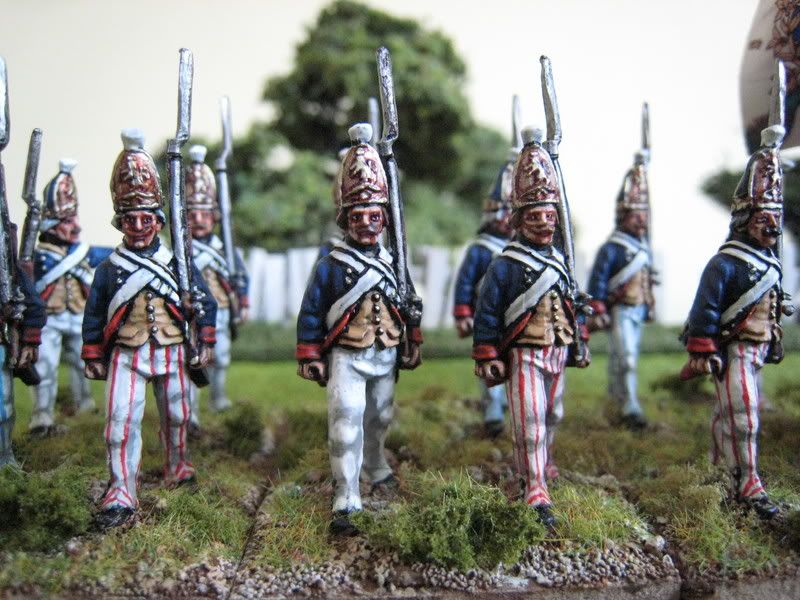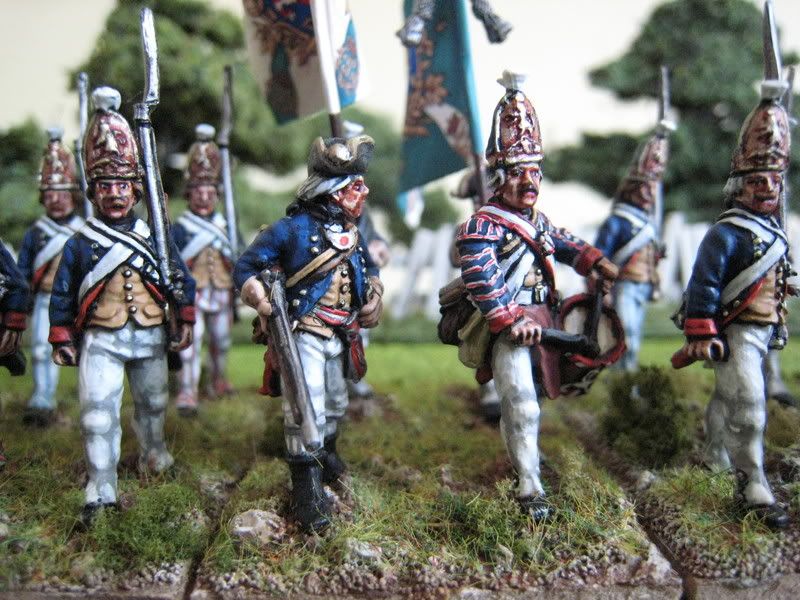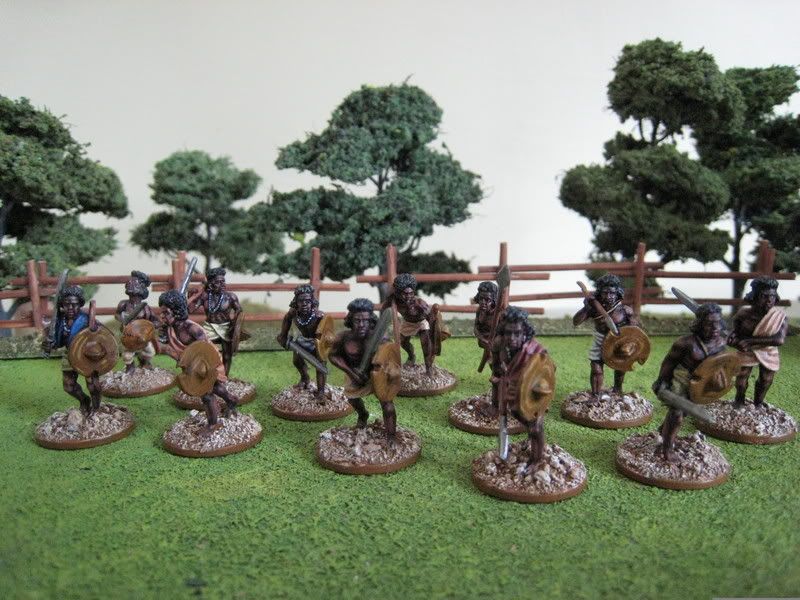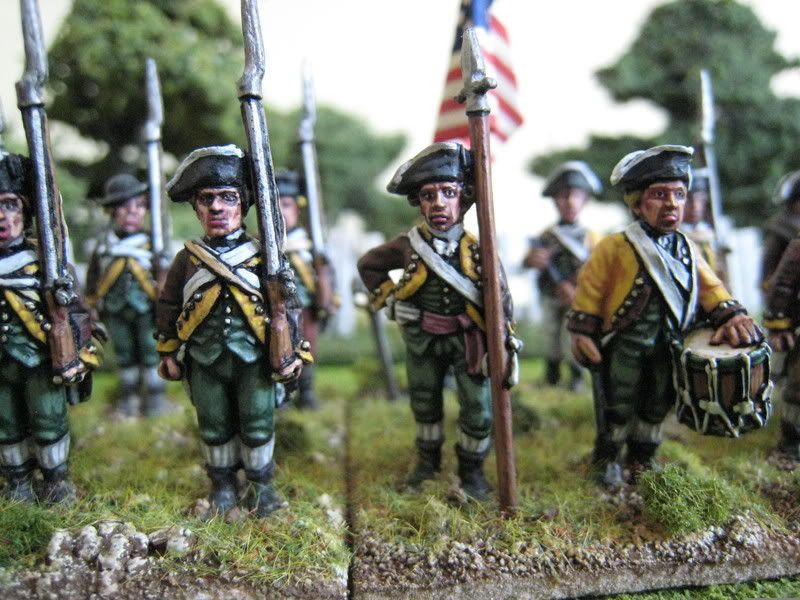
In response to a couple of queries, I thought it might be useful to have a quick run-down on the base sizes I use for the "British Grenadier!" rules. The sizes set out below are commonly used, at least by the London BG fraternity, although they are not essential. Like most rules, BG can be played with different sized bases so long as there is consistency within the troops used on the table. As I have said in some earlier posts, I have introduced more flexibility with the basing of skirmishers (as shown the photo and explained below). I have seen games that have skirmishers based in all kinds of ways, and it makes no difference to how the rules are played or the success of the game. Troops in this war often adopted loose formations and there is no reason why the basing of light and irregular troops should not reflect this. All the measurements given are for 25/28mm figures.
Line infantry: based in fours on 36mm x 50mm or in sixes on 54mm x 50mm. It makes no difference whether you base the unit in fours or sixes. There is no need to try to replicate any company structure in a line unit and the grading of a particular line unit does not affect how it is based. I prefer fours for flexibility, but will happily go with sixes when building units with a strength of 18 or 24 figures. My American regiments are usually built in fours, as I like to have the option of fielding them as 16, 20 or 24 figure units as the scenario requires. Most British regiments in the scenarios tend to be 16 or 18 figures, so I just look at the battles each particular regiment fought in and go with the most common strength. BG requires a certain amount of record-keeping, to monitor casualties and the accumulation of disruption points, so if your 33rd Foot, for example, has 18 figures but the scenario requires only 16, then it is easy to make a note to that effect on the casualty list.
Skirmishers: based in twos on 50mm x 25mm or threes on 75mm x 25mm. The base requirement for each individual figure is therefore 25mm x 25mm. As stated elsewhere on this blog, in BG skirmishers are rated according to grade: First Rate or Second Rate. Examples of First Rate troops would be Hessian jaeger, British light infantry and top class American riflemen. Second Rate skirmishers would be everyone else. The First Rate chaps fire with one D6 for every 2 figures, whilst the Second Raters fire with one D6 for every 3 figures. Therefore, it helps with firing calculations if you base the figures according to the unit's rating: either in twos or in threes. Once you decide on the rating, it is possible to build a bit of flexibility into the basing. I have some American riflemen on larger format bases, to add some terrain features and also because the Perry "prone" figures need a greater depth than 25mm. These bases are 50mm x 40mm. I also base Indians on individual bases of 25mm x 25mm. This is mainly to allow their use in F&IW skirmish games but also reflects my feeling that having 3 Indians in a line on a standard 75mm x 25mm base simply doesn't look right. There is no reason why you couldn't have Indians (or militia for that matter) on a larger round base. Basing skirmishers like Indians singly actually works quite well because you are never going to need many of them for a game (for example, the Freeman's Farm scenario only requires 6 Indians). The photo above shows the different types of skirmish bases that I use.
Cavalry: based in twos on 40mm x 50mm. You can also base them in threes but should keep the frontage to 20mm. I have a number of figures on single bases of 20mm x 50mm, such as the Perry British dragoons in "skirmish" poses, and to assist in the removal of casualties.
Artillery: 1 gun and crew (4 figures) based on 60mm x 70mm. I find this base size can be too small for some gun crew packs, such as the Perry packs of figures aiming and loading guns - you need a bit of extra depth to enable the figures to be positioned properly around the cannon. I just base any figures that need more space separately on pennies.
Brigadier Generals: based singly on 30mm x 50mm. The rules say that Divisional generals should be based on 54mm x 50mm bases, but you are not going to need specific divisional commander figures unless gaming one of the largest battles like Monmouth or Brandywine.
Commanders-in-chief: general and retinue based on 70mm x 60mm (i.e. an artillery base). The Washington, Knyphausen and von Heister stands that I posted on this blog are on bases of this size. Some generals commanded troops at different levels at different times and in my collection this sized base tends to do for any "personality" generals. Greene, for example, commands a division at Brandywine, under Washington's overall command, but reaches c-in-c level for Guilford Courthouse and Hobkirk's Hill. There's no point in buying and painting two Greene personality figures and putting them on separate "divisional general" and "commander-in-chief" stands, so my Foundry Greene figure just gets a 70mm x 60mm base. That worked perfectly well at our Brandywine refight in 2005. Given the relatively smaller number of figures and units involved, AWI games do not become crowded in the way that Napoleonic games at 1:20 scale can often do, so you can afford to be more generous with the basing of generals and staff.
The photo above shows, clockwise from top left, the following based as skirmishers: British light infantry from the 5th Foot, a stand from the 13th Virginia Regiment, an Iroquois indian, American riflemen on the larger format base.






















